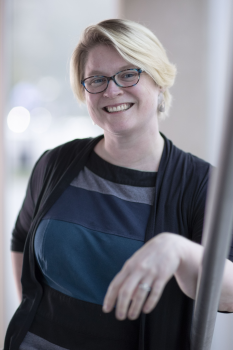SCSAM Fellow Spotlight: Claire Barratt

A Ph.D. candidate in Case Western Reserve University’s Department of Macromolecular Science and Engineering, Claire Barratt’s main engineering interests have always been designing materials that respond well to their environments, “anything from catalysts that work in specific conditions, to sensors, to targeted drug delivery.”
After attending a seminar with the Case School of Engineering’s Swagelok Center for Surface Analysis of Materials (CSE-SCSAM) engineers, Barratt was inspired to apply for a SCSAM fellowship, drawn to the program’s emphasis on “proof of concept” experiments. “Writing my proposal helped me think through a few new methods to characterize my nanoparticle assemblies that just might work,” she said.
The main focus of Barratt’s fellowship is to show the location and composition of each of her assembled nanoparticles. The silica nanoparticles she is working with have polymer “brushes” grafted into their surfaces, and the brushes attract each other in certain environments, sometimes leading the nanoparticles to self-assemble into an ordered crystal. Working with SCSAM’s scanning Auger microprobe on a scanning electron microscope, she has been able to design different polymer brushes and change their solvent or temperature, therefore changing when and how particles assemble. “I’m finding that the best way to get better images is actually to make small changes in how I make the nanoparticles and prepare the samples,” said Barratt, who has enjoyed learning about the instruments’ strengths and weaknesses.
By using Auger electron spectroscopy, Barratt has been able to determine which elements are present across the surfaces of her samples and learn more about the polymer brushes. Scanning electron microscopy has also been helpful for her to determine where particle assemblies are and their size. “It's really cool to learn exactly how sample materials and the instrument’s settings affect the resulting image,” she said.
A National Science Foundation Graduate Research Fellow, Barratt credited her SCSAM fellowship with giving her ideas for characterization methods for future projects. She also thanked SCSAM Senior Research Engineer John Kim for “really rooting for this project to succeed.”
"I have greatly enjoyed working with Claire on the Auger instrument,” said Kim. “Claire has a good grasp on the capabilities and limitations of the instrument and she has been working diligently on exploring different ways of sample preparation to attain the results she needs.”
In addition to her fellowship, Barratt is currently using SCSAM’s atomic force microscope (AFM) to measure the size and thickness of two-dimensional carbon materials. She has used the aforementioned microscope for multiple projects in the past, including one to determine the sizes of star-shaped polymers she made. She appreciated the AFM’s ability to help her visualize absorption of soft polymers on a hard surface.
"I’m so grateful to everyone at SCSAM for their help and support,” said Barratt. “They’re always ready to talk about the project and offer advice on new methods I can try.”

